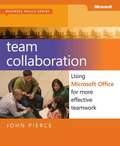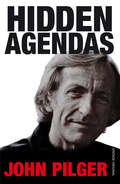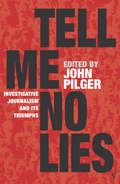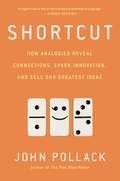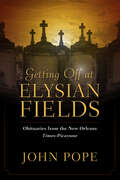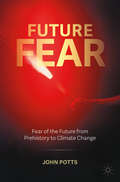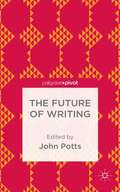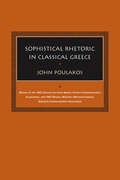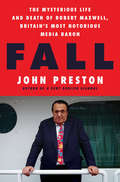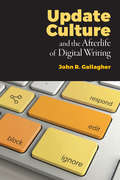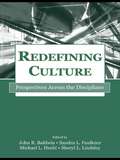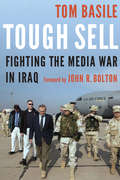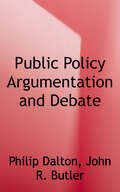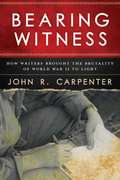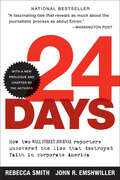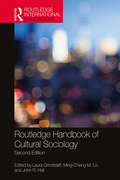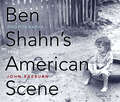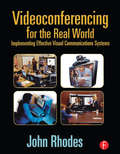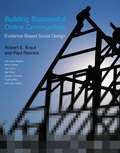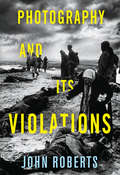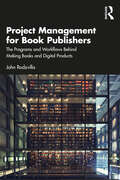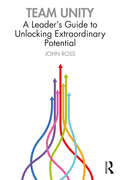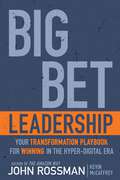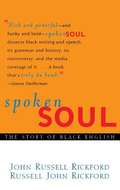- Table View
- List View
Team Collaboration: Using Microsoft® Office for More Effective Teamwork
by John Pierce<p>Whether coordinating a cross-team project or leading your workgroup, discover how to enable your team’s best work using Microsoft Office.</p>
Distant Voices
by John PilgerThroughout his distinguished career as a journalist and film-maker, John Pilger has looked behind the 'official' versions of events to report the real stories of our time.The centrepiece of this new, expanded edition of his bestselling Distant Voices is Pilger's reporting from East Timor, which he entered secretly in 1993 and where a third of the population has died as a result of Indonesia's genocidal policies. This edition also contains more new material as well as all the original essays - from the myth-making of the Gulf War to the surreal pleasures of Disneyland. Breaking through the consensual silence, Pilger pays tribute to those dissenting voices we are seldom permitted to hear.
Hidden Agendas
by John PilgerIn this powerful book, journalist and film maker John Pilger strips away the layers of deception, dissembling language and omission that prevent us from understanding how the world really works. From the invisible corners of Tony Blair's Britain to Burma, Vietnam, Australia, South Africa and the illusions of the 'media age', power, he argues, has its own agenda. Unchallenged, it operates to protect its interests with a cynical disregard for people - shaping, and often devastating, millions of lives. By unravelling the hidden histories of contemporary events, Pilger allows us to read between the lines. He also celebrates the eloquent defiance and courage of those who resist oppression and give us hope for the future. Tenaciously researched and written with passion and wit, Hidden Agendas will change the way you see the world.
Tell Me No Lies: Investigative Journalism and its Triumphs
by John PilgerTell Me No Lies is a celebration of the very best investigative journalism, and includes writing by some of the greatest practitioners of the craft: Seymour Hersh on the My Lai massacre; Paul Foot on the Lockerbie cover-up; Wilfred Burchett, the first Westerner to enter Hiroshima following the atomic bombing; Israeli journalist Amira Hass, reporting from the Gaza Strip in the 1990s; Gunter Wallraff, the great German undercover reporter; Jessica Mitford on 'The American Way of Death'; Martha Gelhorn on the liberation of the death camp at Dachau. The book - a selection of articles, broadcasts and books extracts that revealed important and disturbing truths - ranges from across many of the critical events, scandals and struggles of the past fifty years. Along the way it bears witness to epic injustices committed against the peoples of Vietnam, Cambodia, East Timor and Palestine. John Pilger sets each piece of reporting in its context and introduces the collection with a passionate essay arguing that the kind of journalism he celebrates here is being subverted by the very forces that ought to be its enemy. Taken as a whole, the book tells an extraordinary 'secret history' of the modern era. It is also a call to arms to journalists everywhere - before it is too late.
Shortcut
by John PollackA presidential speechwriter for Bill Clinton explores the hidden power of analogy to fuel thought, connect ideas, spark innovation, and shape outcomes From the meatpacking plants that inspired Henry Ford's first moving assembly line to the "domino theory" that led America into Vietnam to the "bicycle for the mind" that Steve Jobs envisioned as the Macintosh computer, analogies have played a dynamic role in shaping the world around us--and still do today. Analogies are far more complex than their SAT stereotype and lie at the very core of human cognition and creativity. Once we become aware of this, we start seeing them everywhere--in ads, apps, political debates, legal arguments, logos, and euphemisms, to name just a few. At their very best, analogies inspire new ways of thinking, enable invention, and motivate people to action. Unfortunately, not every analogy that rings true is true. That's why, at their worst, analogies can deceive, manipulate, or mislead us into disaster. The challenge? Spotting the difference before it's too late. Rich with engaging stories, surprising examples, and a practical method to evaluate the truth or effectiveness of any analogy, Shortcut will improve critical thinking, enhance creativity, and offer readers a fresh approach to resolving some of today's most intractable challenges.
Getting Off at Elysian Fields: Obituaries from the New Orleans Times-Picayune
by John PopeNo city in America knows how to mark death with more funerary panache than New Orleans. The pageants commemorating departed citizens are often in themselves works of performance art. A grand obituary remains key to this Stygian passage. And no one writes them like New Orleanian John Pope. Collected here are not just simple, mindless recitations of schools and workplaces, marriages, and mourners bereft. These pieces in Getting Off at Elysian Fields: Obituaries from the New Orleans “Times-Picayune” are full-blooded life stories with accounts of great achievements, dubious dabblings, unavoidable foibles, relationships gone sour, and happenstances that turn out to be life-changing. To be sure, there are stories about Carnival monarchs, great philanthropists, and a few politicians. But because New Orleans embraces eccentric behavior, there are stories of people who colored way outside the lines. For instance, there was the doctor who used his plasma to make his flowers grow, and the philanthropist who took money she had put aside for a fur coat to underwrite the lawsuit that desegregated Tulane University. A letter carrier everyone loved turned out to have been a spy during World War II, and a fledgling lawyer changed his lifelong thoughts about race when he saw blind people going into a Christmas party through separate doors—one for white people and another for African Americans. Then there was the punctilious judge who got down on his hands and knees to edge his lawn—with scissors. Because New Orleans funerals are distinctive, the author includes accounts of four that he covered, complete with soulful singing and even some dancing. As a popular, local bumper sticker indisputably declares, “New Orleans—We Put the Fun in Funeral.”
Future Fear: Fear of the Future from Prehistory to Climate Change
by John PottsThis book places the contemporary fear of climate change in historical perspective, showing that throughout human history the dominant perspective on the future has been one of fear. Across a broad historical sweep, the book describes the varied means employed to predict and control the future: magic, religion, science, and technology. Future Fear traces fear of the future from prehistory to the present, culminating in the contemporary fear of imminent climate change catastrophe. Consideration is also given to hope in a more positive future, revealing that visions of the future have often been a mingling of fear and hope.
The Future of Writing
by John PottsThis fascinating collection draws together perspectives on the future of writing in publishing, journalism and online sites. Discussion ranges across the challenges and opportunities for writing and publishing in the context of new content platforms, formats and distribution networks, including e-books, online news and publishing, and social media.
Sophistical Rhetoric in Classical Greece (Studies in Rhetoric & Communication)
by John PoulakosAn expert in rhetoric offers a new perspective on the ancient concept of sophistry, exploring why Plato, Isocrates, and Aristotle found it objectionable.In Sophistical Rhetoric in Classical Greece, John Poulakos argues that a proper understanding of sophistical rhetoric requires a grasp of three cultural dynamics of the fifth century B.C.: the logic of circumstances, the ethic of competition, and the aesthetic of exhibition. Traced to such phenomena as everyday practices, athletic contests, and dramatic performances, these dynamics defined the role of sophistical rhetoric in Hellenic culture and explain why sophistry has traditionally been understood as inconsistent, agonistic, and ostentatious.In his discussion of ancient responses to sophistical rhetoric, Poulakos observes that Plato, Isocrates, and Aristotle found sophistry morally reprehensible, politically useless, and theoretically incoherent. At the same time, they produced their own version of rhetoric that advocated ethical integrity, political unification, and theoretical coherence. Poulakos explains that these responses and alternative versions were motivated by a search for solutions to such historical problems as moral uncertainty, political instability, and social disorder. Poulakos concludes that sophistical rhetoric was as necessary in its day as its Platonic, Isocratean, and Aristotelian counterparts were in theirs.
Fall: The Mysterious Life and Death of Robert Maxwell, Britain's Most Notorious Media Baron
by John PrestonCosta Prize Winner: The “best biography yet” of notorious media mogul Robert Maxwell, “by turns engrossing, amusing, and appalling” (Sunday Times).In February 1991, Robert Maxwell triumphantly sailed into New York Harbor on his yacht, the Lady Ghislaine, to buy the ailing Daily News. Taxi drivers stopped their cabs to shake his hand, children asked for his autograph, and patrons of the hottest restaurant in Manhattan gave him a standing ovation while he dined. Ten months later, Maxwell disappeared off that same yacht in the middle of the night and was later found dead in the water. As John Preston, author of A Very English Scandal, reveals in this biography, Maxwell’s death was as mysterious as his remarkable life.A tightly paced, addictive saga of ambition, hubris, narcissism, greed, power, and intrigue, this book recounts Maxwell’s rise and fall and rise and fall again. Preston moves backward and forward in time to examine the forces that shaped Maxwell, from his Jewish childhood in occupied Eastern Europe to his failed political ambitions in the 1960s that ended in accusations of financial double-dealing to his resurrection as a media mogul—and the family legacy he left behind, including his daughter Ghislaine Maxwell. Preston chronicles Maxwell’s all-encompassing rivalry with Rupert Murdoch—a battle that ruined Maxwell financially, threatened his sanity, and led, indirectly, to his death. Did Maxwell have a heart attack and fall overboard? Was his death suicide? Or was he murdered—possibly by Mossad or the KGB? Few in the twentieth century journeyed as far from his roots as Robert Maxwell. Yet, as Fall reveals, no one, however rich and powerful, can entirely escape their past. “Preston tells [the story] with great verve and the benefit of extensive interviews.” —The Economist“The mystery of this larger-than-life figure is perplexing—true crime aficionados will be absorbed.” —Library Journal“One of the most enigmatic figures in the annals of white-collar crime . . . well-researched, compelling.” —Kirkus Reviews
Update Culture and the Afterlife of Digital Writing
by John R GallagherUpdate Culture and the Afterlife of Digital Writing explores “neglected circulatory writing processes” to better understand why and how digital writers compose, revise, and deliver arguments that undergo sometimes constant revision. John R. Gallagher also looks at how digital writers respond to comments, develop a brand, and evolve their arguments—all post-publication. With the advent of easy-to-use websites, ordinary people have become internet writers, disseminating their texts to large audiences. Social media sites enable writers’ audiences to communicate back to the them, instantly and often. Even professional writers work within interfaces that place comments adjacent to their text, privileging the audience’s voice. Thus, writers face the prospect of attending to their writing after they deliver their initial arguments. Update Culture and the Afterlife of Digital Writing describes the conditions that encourage “published” texts to be revisited. It demonstrates—through forty case studies of Amazon reviewers, redditors, and established journalists—how writers consider the timing, attention, and management of their writing under these ever-evolving conditions. Online culture, from social media to blog posts, requires a responsiveness to readers that is rarely duplicated in print and requires writers to consistently reread, edit, and update texts, a process often invisible to readers. This book takes questions of circulation online and shows, via interviews with both writers and participatory audience members, that writing studies must contend with writing’s afterlife. It will be of interest to researchers, scholars, and students of writing studies and the fields of rhetoric, communication, education, technical communication, digital writing, and social media, as well as all content creators interested in learning how to create more effective posts, comments, replies, and reviews.
Redefining Culture: Perspectives Across the Disciplines (Routledge Communication Series)
by John R. Baldwin Michael L. Hecht Sandra L. Faulkner Sheryl L. LindsleyRedefining Culture: Perspectives Across the Disciplines argues that culture is one of the most important factors we need to know when we interact as well as in our discussions of social problems and their solutions. This book picks up the dialogue where Kroeber and Kluckhohn left off in their classic 1952 collection and analysis of definitions of culture. As a resource for personal and academic libraries, this volume provides an updated listing of over 300 definitions of culture from a wide array of disciplines. Chapters examine how the definition of culture has changed historically, consider themes that cut across the definitions, and provide models for organizing approaches to defining culture. To round out this multi-disciplinary perspective, Renato Rosaldo provides a foreword, and prominent authors from six disciplines write about how they conceptualize culture and use it in their research and practice. This resource is an indispensable reference for scholars studying or integrating culture into their work. It will appeal to anyone interested in culture, particularly students and scholars in anthropology, intercultural and international communication, cultural studies, cultural and social psychology, linguistics, sociology, family studies, political science, intergroup relations, cultural geography, and multicultural education.
Tough Sell: Fighting the Media War in Iraq
by John R. Bolton Tom BasileLike the War on Terror, the Media War rages on. More than ever, America’s ability to fight and win against ISIS requires that we understand how best to communicate about war in the digital age. Tom Basile takes readers behind the scenes during his time as a civilian advisor in Iraq during the Iraq War, describing his mission and the struggle to communicate about the war as it became more deadly and less popular at home. The U.S.-led coalition wasn’t merely engaged in a fight to build a more tolerant, participatory society against incredible odds. It was also in a constant clash with forces that influenced public perception about the mission. During those difficult years, it became clear that warfare was now, more than ever, a blend of policy, politics, and the business of journalism. Basile critiques the media’s reporting and assesses the Bush administration’s home-front communications strategy to argue that if policymakers fail to effectively articulate their strategy, manage their message, and counter misinformation, they will find themselves unable to execute that policy. That, Basile argues, places the United States at great risk. Tough Sell blends Basile’s personal story with lessons from the media war in Iraq that can improve our ability to communicate about and prosecute the War on Terror.
Public Policy Argumentation and Debate: A Practical Guide for Advocacy
by Philip Dalton John R. ButlerThrough an exclusive focus on public policy advocacy as a practical endeavor, the authors Philip Dalton and John R. Butler depart from approaches to debate education that focus on the rules of simulated, academic debate formats. Beginning with the assumption that readers have already developed a basic capacity to argue, they offer practical guidance for determining the fundamental issues that make up a controversy and what expectations public audiences will have for advocacy based on the issues and the burdens of advocates challenging or defending the status quo. Through examples that span a wide range of advocacy situations and subjects of contemporary importance, the authors build a framework for public policy advocacy that is organic to the communication discipline, recover and refresh foundational lessons about the uses of evidence, and provide critical questions that can be used to develop and communicate policy proposals that are sensible and appealing. Written in an accessible, respectful, and motivational style, the book is suitable for students of debate, professionals who function as advocates, and people who find themselves wishing to voice their opinion on an issue of concern.
Bearing Witness: How Writers Brought the Brutality of World War II to Light
by John R. CarpenterIt has been said that during times of war, the Muses fall silent. However, anyone who has read the major figures of mid-twentieth-century literature—Samuel Beckett, Richard Hillary, Norman Mailer, Albert Camus, Jean-Paul Sartre, and others—can attest that it was through writing that people first tried to communicate and process the horrors that they saw during one of the darkest times in human history even as it broke out and raged on around them.In Bearing Witness, John Carpenter explores how across the world those who experienced the war tried to make sense of it both during and in its immediate aftermath. Writers such as Alexander Solzhenitsyn and Theodore Plievier questioned the ruling parties of the time based on what they saw. Correspondents and writer-soldiers like John Hersey and James Jones revealed the chaotic and bloody reality of the front lines to the public. And civilians, many of who remain anonymous, lent voice to occupation and imprisonment so that those who didn’t survive would not be forgotten. The digestion of a cataclysmic event can take generations. But in this fascinating book, Carpenter brings together all those who did their best to communicate what they saw in the moment so that it could never be lost.
24 Days: How Two Wall Street Journal Reporters Uncovered the Lies that Destroyed Faith in Corporate America
by John R. Emshwiller Rebecca SmithNATIONAL BESTSELLER—with a new prologue and chapter by the authors. “A fascinating tale that reveals as much about the journalistic process as about Enron.” —The Washington PostThis is the story of Rebecca Smith and John R. Emshwiller, the two reporters who led the Wall Street Journal’s reporting on Enron and uncovered the unorthodox partnerships at the heart of the scandal through skill, luck, and relentless determination.It all started in August 2001when Emshwiller was assigned to write a supposedly simple article on the unexpected resignation of Enron CEO Jeff Skilling. During his research, Emshwiller uncovered a buried reference to an off-balance-sheet partnership called LJM. Little did he know, this was the start of a fast and furious ride through the remarkable downfall of a once highly-prized company.Written in an intense, fast paced narrative style, 24 Days tells the gripping story of the colossal collapse of what would become the world’s most notorious corporation. The reader follows along as Smith and Emshwiller continue to uncover new partnerships and self-dealing among the highest levels of Enron’s management. As they publish articles detailing their findings in the Journal, Wall Street and individual investors have a crisis of confidence and start selling Enron stock at unprecedented levels of volume. In the end—24 short days later—Enron had completely collapsed, erasing 16 years of growth and losing $19 billion in market value while watching the stock drop from $33.84 to $8.41. Not only was the company destroyed, but investors and retired employees were completely wiped out—all the while Enron executives were collecting millions of dollars.“Gripping . . . the best of the Enron books yet.” —USA Today
Routledge Handbook of Cultural Sociology: 2nd Edition (Routledge International Handbooks)
by John R. Hall Laura Grindstaff Ming-Cheng M. LoThe thoroughly revised and updated second edition of the Routledge Handbook of Cultural Sociology provides an unparalleled overview of sociological and related scholarship on the complex relations of culture to social structures and everyday life. With 70 essays written by scholars from around the world, the book brings diverse approaches into dialogue, charting new pathways for understanding culture in our global era. Short, accessible chapters by contributing authors address classic questions, emergent issues, and new scholarship on topics ranging from cultural and social theory to politics and the state, social stratification, identity, community, aesthetics, and social and cultural movements. In addition, contributors explore developments central to the constitution and reproduction of culture, such as power, technology, and the organization of work. This handbook is essential reading for undergraduate and postgraduate students interested in a wide range of subfields within sociology, as well as cultural studies, media and communication, and postcolonial theory.
Ben Shahn's American Scene: Photographs, 1938
by John RaeburnThe paintings, murals, and graphics of Ben Shahn (1898-1969) have made him one of the most heralded American artists of the twentieth century, but during the 1930s he was also among the nation's premier photographers. Much of his photographic work was sponsored by the New Deal's Farm Security Administration, where his colleagues included Dorothea Lange and Walker Evans. Ben Shahn's American Scene: Photographs, 1938 presents one hundred superb photographs from his most ambitious FSA project, a survey of small-town life in the Depression. John Raeburn's accompanying text illuminates the thematic and formal significance of individual photographs and reveals how, taken together, they address key cultural and political issues of the years leading up to World War II. Shahn's photographs highlight conflicts between traditional values and the newer ones introduced by modernity as represented by the movies, chain stores, and the tantalizing allure of consumer goods, and they are particularly rich in observation about the changes brought about by Americans' universal reliance on the automobile. They also explore the small town's standing as the nation's symbol of democratic community and expose the discriminatory social and racial practices that subverted this ideal in 1930s America.
Videoconferencing for the Real World: Implementing Effective Visual Communications Systems
by John Rhodes"John Rhodes' Videoconferencing for the Real World, is a one of the world's most comprehensive blueprints on the awesome power of videoconferencing."From the Foreword by Brad CaldwellChairman ICIA and President ofIntegrated Media Services, Anaheim, CADesigned to be useful to both technical and non-technical managers, Video-Conferencing for the Real World demystifies the subject of video communications. It provides easy-to-follow guidelines for deploying a cost-effective video-conferencing solution tailored to an organization's specific needs.Developed to flexible to the readers need, Video Conferencing for the Real World offers dynamic problem-solving techniques for the communication challenges facing managers today. Examining the technical, economic, and organizational aspects of each requirement and solution, this book offers a sound base of technical information and provides practical solutions based on a wealth of professional experience. Combining his own ideas with the input of system managers and users, service providers, consultants, and manufacturers, the author has developed a guide that will help readers make more informed investments of their time and money. Special attention is paid to conducting an effective needs analysis, and the development of solutions that will adapt easily to future changes in organizational requirements.Covering a variety of solutions, this book explores the advantages and disadvantages of desktop systems, set-top systems, rollabout systems, and room systems. In addition to compression, multipoint conferencing and data conferencing, this book also addresses topics such as, pilot projects, the preparation of RFPs, service contracts, training, content creation, and convergence.
Building Successful Online Communities: Evidence-Based Social Design
by John Riedl Joseph Konstan Yan Chen Moira Burke Niki Kittur Paul Resnick Robert E. Kraut Sara Kiesler Yuqing RenOnline communities are among the most popular destinations on the Internet, but not all online communities are equally successful. For every flourishing Facebook, there is a moribund Friendster -- not to mention the scores of smaller social networking sites that never attracted enough members to be viable. This book offers lessons from theory and empirical research in the social sciences that can help improve the design of online communities.The authors draw on the literature in psychology, economics, and other social sciences, as well as their own research, translating general findings into useful design claims. They explain, for example, how to encourage information contributions based on the theory of public goods, and how to build members' commitment based on theories of interpersonal bond formation. For each design claim, they offer supporting evidence from theory, experiments, or observational studies.
Photography and Its Violations (Columbia Themes in Philosophy, Social Criticism, and the Arts)
by John RobertsTheorists critique photography for "objectifying" its subjects and manipulating appearances for the sake of art. In this bold counterargument, John Roberts recasts photography's violating powers of disclosure and aesthetic technique as part of a complex "social ontology" that exposes the hierarchies, divisions, and exclusions behind appearances.The photographer must "arrive unannounced" and "get in the way of the world," Roberts argues, committing photography to the truth-claims of the spectator over the self-interests and sensitivities of the subject. Yet even though the violating capacity of the photograph results from external power relations, the photographer is still faced with an ethical choice: whether to advance photography's truth-claims on the basis of these powers or to diminish or veil these powers to protect the integrity of the subject. Photography's acts of intrusion and destabilization, then, constantly test the photographer at the point of production, in the darkroom, and at the computer, especially in our 24-hour digital image culture. In this game-changing work, Roberts refunctions photography's place in the world, politically and theoretically restoring its reputation as a truth-producing medium.
Project Management for Book Publishers: The Programs and Workflows Behind Making Books and Digital Products
by John RodzvillaProject Management for Book Publishers provides readers with a solid understanding of efficient processes and workflows for content creation, product development, and the marketing and distribution of both physical and digital products.Digital has brought more data, more training, and more accountability to the publishing process. But it has also shone light on how systems designed initially around print-first publications are ill-equipped to support an industry of now would-be digital media companies. This book addresses some of the major challenges for publishing houses facing this reality, including how to create a digital-aware workflow, implementing quality assurance procedures, and using different management systems to develop an efficient workflow. Beginning by explaining project and product management practices used throughout technology and media companies, it then delves into when and how these principles can be applied to the publishing workflow. Topics covered include Waterfall and Agile Project Management, Scrum methodology, Kanban framework, ebook and audio formats, metadata, quality assurance, crowdfunding, in-app monetization, ONIX, and accessibility. Readers will consider not just how to contend with online platforms that allow authors to publish with the click of a button, and audiences accustomed to accessing content across multiple platforms and formats, but also challenges arising from factors such as the data-driven acquisitions model in libraries, the downward spiral of sales in college bookstores, the call for accessibility, and the need for fluid content systems that can work with different publishing databases and software.Written for publishing professionals at all levels, this book will also help advanced students of Publishing and Book Studies navigate best practices for project management in the modern publishing landscape.
Team Unity: A Leader's Guide to Unlocking Extraordinary Potential
by John RossBased on more than ten years of researching, observing, coaching, and building extraordinary teams, this entertaining and thought-provoking book demonstrates how to unify groups of all sizes to maximize performance. Unity is the most influential factor in team performance and, although it is frequently discussed, it is often misunderstood. This book explains how disunity is the root cause of all team dysfunctions, and provides clear instructions on how to define, measure, and increase unity in your organization. Through entertaining and impactful stories, John Ross divides Team Unity into four components - focus, direction, trust, and conflict – and examines how they are related and measured. Notably, Ross introduces The Unity Formula: a simple equation useful for leaders at all levels in any organization to measure the team’s current unity and identify areas for improvement. Senior and middle managers in manufacturing, hospitality, and a range of other industries, as well as entry level employees and students of organizational behavior and HRM, will find this book an invaluable resource for understanding how to identify, measure and partake in the right steps to increase team performance.
Big Bet Leadership: Your Transformation Playbook for Winning in the Hyper-Digital Era
by John Rossman Kevin McCaffreyThe Executive Playbook to Lead Business Growth, Innovation and Transformation.The first leadership book for the age of artificial intelligence, equipping leaders with principles and tactics to achieve audacious outcomes and solve complex problems, while smartly managing the inherent risks of bold moves. Applying this playbook will impact your business and, just as critically, propel and protect your career as a bold transformational executive. Co-authored by John Rossman, author of The Amazon Way and Think Like Amazon, and Kevin McCaffrey, seasoned executives from Amazon, Google, and T-Mobile. This fast-moving book melds their direct leadership experiences with comprehensive research and authentic stories. Actionable insights include: Pinpointing Growth Opportunities: Identify your customer's primary frustrations and unmet needs with standout features, forming the foundation for sustainable business growth. Mastering Strategic Communication: Develop skills to ensure alignment, clarity, and vital stakeholder involvement through effective strategic communication. Prioritizing through High-Impact Experimentation: Implement cost-effective, swift, and impactful experimentation methods, utilizing memos and debates for maximum effect. Redefining Cost Models for Winning Business Models: Learn to innovate cost structures alongside improving customer experiences for a transformative impact on your business. Overcoming Inertia and Analysis Paralysis: Discover tactics to break free from conventional pace and decision-making traps by creating focused teams and unique operational environments. Maximizing Return on Effort: Craft a governance approach that provides high quality, timely signals for your strategic endeavors without the usual bureaucratic overhead. With your book purchase you also get a trove of resources including practical frameworks, real-world examples, a Big Bet journal, generative AI prompts , and a Big Bet GPT. These tools are designed to drive active integration of the principles of Big Bet Leadership in your business.
Spoken Soul: The Story of Black English
by John Russell Rickford Russell John Rickford"Spoken Soul brilliantly fills a huge gap... a delightfully readable introduction to the elegant interweave between the language and its culture."-Ralph W. Fasold, Georgetown University. "A lively, well-documented history of Black English... that will enlighten and inform not only educators, for whom it should be required reading, but all who value and question language." -Kirkus Reviews. "Spoken Soul is a must read for anyone who is interested in the connection between language and identity." -Chicago Defender Claude Brown called Black English "Spoken Soul." Toni Morrison said, "It's a love, a passion. Its function is like a preacher's: to make you stand out of your seat, make you lose yourself and hear yourself. The worst of all possible things that could happen would be to lose that language." Now renowned linguist John R. Rickford and journalist Russell J. Rickford provide the definitive guide to African American vernacular English from its origins and features to its powerful fascination for society at large.
